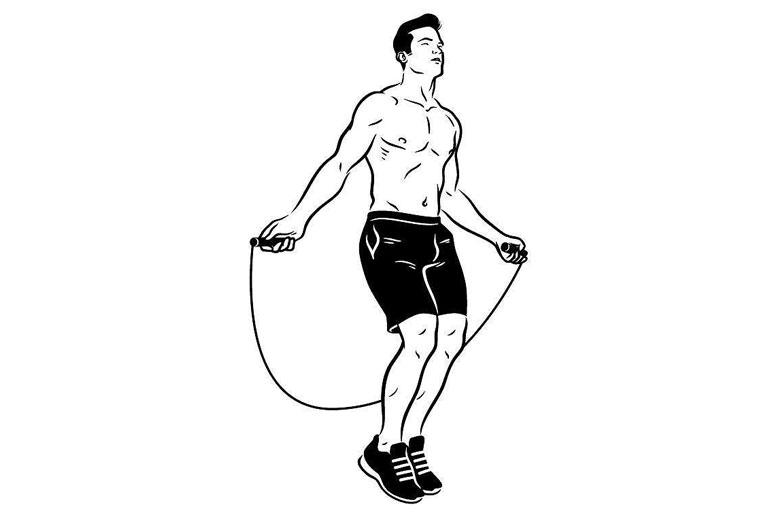With the COVID-19 lockdown limiting gym access, finding effective home workout alternatives becomes crucial. Skipping rope emerges as a super-convenient and efficient option. It’s a fantastic cardio and aerobic exercise that not only helps improve cardiovascular health but also tones calves, tightens the core, builds stamina, and enhances lung capacity. While skipping rope alone may not lead to significant weight loss, incorporating it into a balanced diet and exercise regimen can boost metabolism and contribute to overall fitness goals.
Calories burn in skipping:
Skipping rope is indeed a highly effective calorie-burning exercise. It can burn approximately 10 calories per minute, making it a fantastic choice for those looking to shed calories and tone various muscle groups. With just a 10-minute session each day, you can burn around 200 calories. This calorie burn rate is comparable to, if not more effective than, activities like brisk walking. Additionally, skipping rope helps strengthen not only your legs but also your butt, shoulders, belly, and arms, making it a comprehensive and efficient workout option.
Benefits of skipping rope:
Skipping rope offers numerous benefits for overall health and well-being. Here’s a detailed breakdown of its advantages:
- Improves Heart Health: Skipping rope is an excellent cardiovascular exercise that elevates the heart rate, reducing the risk of heart diseases and stroke. Consistent skipping helps maintain heart health by improving circulation and strengthening the heart muscle.
- Increases Concentration: Engaging in skipping rope exercises can enhance concentration and focus. The rhythmic movement and coordination required in skipping can help calm the mind and improve mental clarity.
- Improves Coordination: Regular skipping improves coordination skills as it involves timing and rhythm. This improvement in coordination extends to various daily activities and sports.
- Increases Stamina and Reduces Fatigue: Continuous skipping builds endurance and stamina over time. Regular practice helps combat fatigue and boosts overall energy levels, making daily activities easier to perform.
- Increases Body Flexibility: Skipping rope exercises contribute to muscle flexibility and relaxation. The repetitive jumping motion strengthens muscles and promotes flexibility, making it beneficial for athletes and individuals seeking improved mobility.
- Boosts Mental Health: Skipping rope at moderate intensity can alleviate symptoms of anxiety and depression by increasing blood circulation to the body and brain. Exercise releases endorphins, promoting feelings of well-being and positivity.
- Decreases Belly Fat: High-intensity skipping, especially in the form of interval training, can effectively reduce belly fat and strengthen abdominal muscles. This form of exercise contributes to overall weight loss and toning.
- Strengthens Bones: Skipping rope exercises promote bone density and strength, reducing the risk of osteoporosis. The impact of jumping stimulates bone growth, particularly in weight-bearing bones like the hips and legs.
- Enhances Skin Health: Regular exercise, including skipping, promotes healthy blood flow and oxygenation to the skin, resulting in a post-workout glow. Improved circulation helps nourish the skin cells, promoting a healthy complexion.
- Improves Pulmonary Function: Skipping rope exercises improve lung capacity and function by enhancing blood circulation and breathing. This benefits overall respiratory health and increases endurance during physical activities.
Incorporating skipping rope into your fitness routine can lead to numerous health benefits, ranging from improved cardiovascular health to enhanced mental well-being. Regular practice and consistency are key to maximizing these advantages.
Skipping rope for weight loss:
Skipping rope can be a valuable tool in a weight loss regimen due to its numerous benefits. Firstly, it’s a highly effective cardiovascular exercise that helps burn calories rapidly, contributing to weight loss. Additionally, skipping rope engages multiple muscle groups simultaneously, promoting muscle tone and increasing overall calorie expenditure. Furthermore, it’s a convenient and accessible exercise that can be done virtually anywhere with minimal equipment. However, it’s important to note that skipping rope alone is not sufficient for weight loss; it should be combined with a well-planned diet, clear weight loss goals, commitment, and a high level of physical activity.
Factors such as age, previous illnesses, or surgeries should also be considered before starting any exercise program, as they may impact the rate of weight loss. Therefore, while skipping rope can be an effective component of a weight loss strategy, it’s essential to adopt a comprehensive approach that addresses diet, exercise, and individual health considerations for optimal results.
Effectiveness of skipping in weight loss:
Skipping rope is indeed an effective exercise for weight loss due to its ability to engage multiple muscle groups and elevate heart rate, resulting in calorie burn. Here’s an overview of its effectiveness and considerations for weight loss:
- Muscle Engagement and Calorie Burn: Skipping rope activates various muscle groups throughout the body, including the legs, arms, core, and shoulders. This comprehensive engagement leads to increased calorie expenditure, aiding in weight loss when combined with a calorie-controlled diet.
- Adjustable Intensity Levels: Beginners can start with low-intensity skipping and gradually increase the intensity as they improve coordination and stamina. Higher intensity skipping, such as incorporating intervals or double unders, can further enhance calorie burn and weight loss.
- Affordability and Accessibility: Skipping rope is a cost-effective exercise option that requires minimal equipment. It can be done virtually anywhere, making it accessible for individuals looking to incorporate regular physical activity into their daily routine.
- Combination with Balanced Diet: While skipping rope can contribute to weight loss, it’s essential to combine it with a balanced diet for optimal results. A nutritious diet that includes a variety of whole foods, lean proteins, fruits, and vegetables supports weight loss efforts and overall health.
- Celebrity Endorsement: Many celebrities, including Jennifer Garner, Justin Bieber, Kate Hudson, Kim Kardashian, and Kayley Cuoco, incorporate skipping rope into their fitness routines. Their endorsement highlights the effectiveness of skipping as a cardiovascular exercise for weight loss and body transformation.
Incorporating skipping rope into a well-rounded fitness regimen that includes strength training, flexibility exercises, and cardiovascular activities can enhance weight loss efforts and promote overall health and fitness. Consistency, proper technique, and gradual progression in intensity are key factors for maximizing the effectiveness of skipping rope for weight loss.
Precautions:
These precautions can help ensure a safe and effective skipping rope workout:
- Warm-up: Prior to jumping rope, it’s essential to warm up your muscles and joints to prevent injury. Spend at least 10 minutes performing dynamic stretches or light cardiovascular exercises to increase blood flow and flexibility.
- Wear Shock-Absorbing Socks: To minimize the risk of injury from the impact of jumping, consider wearing shock-absorbing socks or cushioned footwear. This can help protect your feet and ankles and reduce strain on your joints.
- Stay Hydrated: Hydration is crucial during exercise, so make sure to drink electrolyte water before and after your skipping rope session. Electrolytes help replenish lost minerals and maintain proper fluid balance in the body, especially if you’re sweating heavily.
- Supportive Sports Bra: For women, wearing a supportive sports bra is important during high-impact activities like jumping rope. A good sports bra can provide adequate support and minimize breast movement, reducing discomfort and potential strain on breast tissue.
By following these precautions, you can minimize the risk of injury and maximize the benefits of your skipping rope workout. Remember to listen to your body and stop exercising if you experience any pain or discomfort.
Avoid Injuries When Skipping Rope:
- Recognize Signs of Injury: Learn to differentiate between normal muscle soreness and injury-associated pain. Muscle soreness feels like tiredness and tightness that improves with stretching, while injury pain includes shooting pain, swelling, and persistent fatigue.
- Choose the Right Surface: Opt for surfaces with good shock absorption, such as wooden or rubber flooring, to reduce the risk of injury. Avoid hard surfaces like asphalt and concrete, and if you must skip on them, lower the intensity of your workout.
- Invest in Quality Shoes: Proper footwear is crucial for injury prevention. Invest in high-quality shoes that provide effective shock absorption, comfort, and support to reduce the impact on your joints and muscles.
- Monitor Skipping Volume: Avoid overdoing it, especially if you’re a beginner. Too much skipping too soon can lead to stress on your body and increase the risk of injury. Incorporate rest days into your routine and vary the intensity and duration of your workouts.
- Prioritize Warm-Up: Always start your skipping session with a proper warm-up to gradually elevate your heart rate and increase blood flow to your muscles. This prepares your body for the workout and reduces the risk of injury.
- Don’t Skip Stretching: Include a comprehensive stretching routine in your workout regimen to improve flexibility and prevent muscle tightness. Dedicate time for stretching on rest days and incorporate yoga asanas into your routine for effective stretching.
By following these tips, you can minimize the risk of injuries while skipping rope and enjoy a safe and effective workout experience. Remember to listen to your body, prioritize proper form and technique, and gradually progress in your skipping routine to achieve your fitness goals safely.
Prevent Injuring your joints:
- Keep the Rope at a Lower Angle: Adjust the height of the rope to ensure it’s close to the ground. Keeping the rope at a lower angle reduces the distance your feet need to clear during each jump, minimizing the impact on your joints.
- Soft and Smooth Landings: Focus on landing softly and smoothly with each jump. Bend your knees slightly upon landing to absorb the impact and distribute it evenly across your muscles and joints. Avoid landing with stiff legs, as this can increase the strain on your joints.
By keeping the rope at a lower angle and prioritizing soft landings, you can help protect your joints and enjoy a safer skipping rope workout. Remember to start slowly, gradually increasing the intensity and duration of your sessions as your fitness level improves.
Jump rope is indeed an exceptional exercise:
- Cardiovascular Fitness and Coordination: Jumping rope is an effective way to improve cardiovascular fitness while also enhancing coordination and agility.
- Calorie Burning: It’s a calorie-burning powerhouse, with estimates suggesting it can torch around 10-16 calories per minute, making it an efficient workout for weight management.
- Flexibility Enhancement: Research indicates that freestyle rope skipping surpasses traditional jump rope techniques in enhancing flexibility, particularly among adolescents.
- Charitable Impact: Initiatives like Jump Rope for Heart have made a significant impact, raising over $327 million for the American Heart Association, highlighting its role not only in fitness but also in philanthropy.
- Mental Focus and Concentration: Jumping rope requires focus and concentration, making it not only a physical workout but also a mental one, sharpening cognitive skills in addition to improving physical health.
These points collectively emphasize the multifaceted benefits of incorporating jump rope into one’s fitness routine.
Disclaimer:
The information contained in this article is for educational and informational purposes only and is not intended as a health advice. We would ask you to consult a qualified professional or medical expert to gain additional knowledge before you choose to consume any product or perform any exercise.








